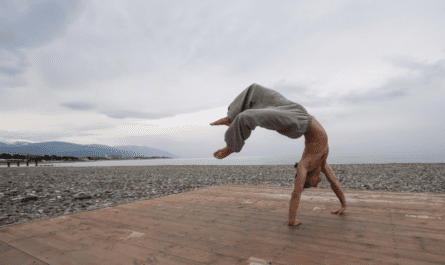Introduction
Mastering the handstand is a remarkable feat of balance, strength, and body control. Whether you’re a gymnast, yogi, or fitness enthusiast, achieving a steady handstand can enhance your physical abilities and add a new dimension to your workout routine. This guide will walk you through everything you need to know about performing a handstand, from basic preparations to advanced techniques, ensuring a comprehensive understanding of this impressive skill.
Understanding the Handstand
What is a Handstand?
A handstand is a gymnastic skill where an individual balances on their hands with their body extended vertically. This position requires a combination of strength, flexibility, balance, and body awareness.
Benefits of Performing a Handstand
- Strength Building: Engages multiple muscle groups, including the shoulders, arms, core, and legs.
- Improved Balance: Enhances your sense of balance and spatial awareness.
- Flexibility and Mobility: Increases shoulder and wrist flexibility.
- Mental Focus: Requires concentration and mental discipline, improving overall cognitive function.
Preparatory Steps for a Handstand
Assessing Your Fitness Level
Before attempting a handstand, evaluate your current fitness level. Ensure you have a basic level of strength and flexibility, particularly in your upper body and core.
Warm-Up Exercises
- Cardio Warm-Up: Engage in light cardio, such as jogging or jumping jacks, to increase blood flow.
- Dynamic Stretches: Perform dynamic stretches like arm circles, leg swings, and hip rotations.
Strength Training
Focus on building strength in the key areas required for a handstand:
- Shoulders: Perform shoulder presses and lateral raises.
- Arms: Incorporate bicep curls, tricep dips, and push-ups.
- Core: Do planks, sit-ups, and leg raises.
Basic Handstand Techniques
Finding Your Balance Point
Your balance point is where your body weight is evenly distributed over your hands. Practice finding this point by shifting your weight back and forth on your hands while in a standing position.
Wall-Assisted Handstands
- Step-by-Step Guide:
- Stand facing a wall about a foot away.
- Place your hands on the ground, shoulder-width apart.
- Kick your feet up to the wall, using the wall for support.
- Hold the position, gradually increasing your hold time as you become more comfortable.
Free-Standing Handstands
- Step-by-Step Guide:
- Start in a lunge position.
- Place your hands on the ground, shoulder-width apart.
- Kick up with your back leg, bringing both legs together overhead.
- Engage your core and look between your hands to maintain balance.
Advanced Handstand Techniques
Handstand Push-Ups
- How to Perform:
- Start in a handstand position against a wall.
- Lower your head to the ground by bending your elbows.
- Push back up to the starting position.
One-Arm Handstands
- How to Perform:
- Start in a free-standing handstand.
- Shift your weight to one hand while lifting the other off the ground.
- Hold the position, then switch hands.
Common Mistakes and How to Avoid Them
Overarching the Back
Maintain a neutral spine to prevent overarching. Engage your core and keep your ribs tucked in.
Bent Arms
Ensure your arms are fully extended to provide a stable base for your handstand.
Inconsistent Kicking Up
Practice controlled kicking to achieve a smooth transition into the handstand position.
Tips for Mastering the Handstand
Consistent Practice
Regular practice is crucial for mastering a handstand. Dedicate time each day to practice and gradually increase the duration of your holds.
Mindful Breathing
Focus on your breathing to maintain calmness and stability. Inhale deeply before kicking up and exhale steadily while holding the position.
Visualizing Success
Visualize yourself performing a perfect handstand. Mental imagery can enhance your physical performance and boost your confidence.
Safety Considerations
Using Spotters
Have a spotter assist you during the initial stages of learning a handstand to ensure safety and provide guidance.
Practicing on Soft Surfaces
Use a padded mat or practice on grass to reduce the risk of injury in case of a fall.
Conclusion
Mastering a handstand is a rewarding endeavor that combines physical strength, balance, and mental focus. By following the detailed steps and techniques outlined in this guide, you can achieve and maintain a handstand, reaping the numerous benefits it offers. Dedication, consistent practice, and mindful training are key to mastering this impressive skill.
FAQ
Q: How long does it take to learn a handstand? A: The time it takes to learn a handstand varies depending on your current fitness level and practice frequency. With consistent practice, many people can achieve a handstand in a few months.
Q: Can anyone learn to do a handstand? A: Yes, most people can learn to do a handstand with proper training and dedication, regardless of their starting fitness level.
Q: Is it safe to practice handstands at home? A: Yes, it is safe to practice handstands at home if you take proper precautions, such as using a padded mat and practicing near a wall.
Q: What muscles are most important for a handstand? A: The shoulders, arms, and core muscles are the most important for maintaining a stable handstand.
Q: How can I improve my balance for a handstand? A: Improving balance for a handstand involves strengthening your core, practicing balance exercises, and performing handstands regularly to develop muscle memory.





